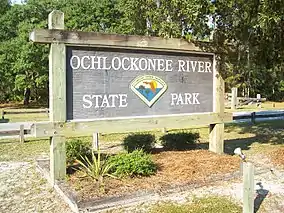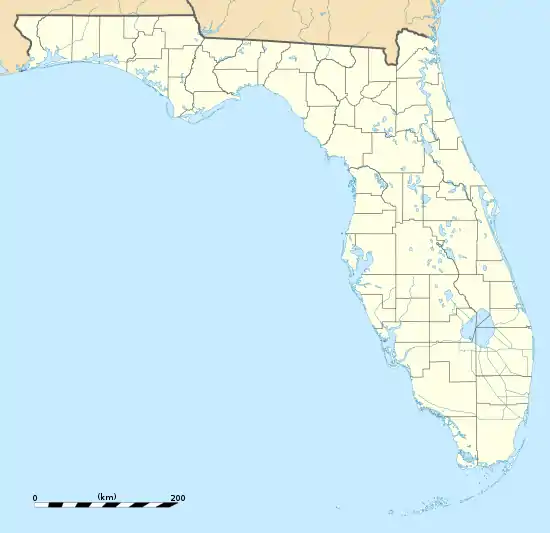Ochlockonee River State Park
Ochlockonee River State Park is a Florida State Park located in Wakulla County, Florida, south of the town of Sopchoppy in the Florida Panhandle. Located off of U.S. 319 on the Ochlockonee River, just north of the Gulf of Mexico coast, it is surrounded by the Apalachicola National Forest and the St. Marks National Wildlife Refuge and provides important habitat for the endangered red-cockaded woodpecker.
| Ochlockonee River State Park | |
|---|---|
IUCN category V (protected landscape/seascape) | |
 | |
 | |
| Location | Wakulla County, Florida, United States |
| Nearest city | Sopchoppy |
| Coordinates | 29°59′57″N 84°29′06″W |
| Area | 543 acres (220 ha) |
| Governing body | Florida Department of Environmental Protection |
History
Established in 1970, Ochlockonee River State Park is located on the Ochlockonee River where it joins with the Sopchoppy River and Dead River to form Ochlockonee Bay, approximately 4 miles (6.4 km) south of Sopchoppy, Florida, and is accessed from U.S. Route 319.[1] The park covers an area of 543 acres (220 ha),[2] while the Apalachicola National Forest and St. Marks National Wildlife Refuge surround the park,[3][4] producing a net contiguous area of 632,000 acres (256,000 ha) of protected lands.[5] The park was once populated by Native American peoples of the Weeden Island culture in the 300–1000 AD period. During the 1700s, the park area was home to an active turpentine industry, with "cat-faced" pine trees, marked by the turpentine harvesting process, still visible in many locations.[2]
Ecology
Ochlockonee River State Park's primary ecologic biome is East Gulf coastal plain near-coast pine flatwoods, with some live oak thickets also present within the park boundaries;[4][2] several species of golden wiregrass can be found in abundance within the park.[6] The park is considered to be one of the best remaining examples of a natural flatwoods environment in the state,[7] and it contains a significant habitat for the endangered red-cockaded woodpecker, which nests in longleaf pines. In addition to a large number of other birds,[5] bobcat, American black bear, white-tailed deer, gopher tortoise and fox squirrel are also resident;[6] a population of white-colored squirrels, a genetic mutation of the eastern gray squirrel,[7] are often found at the park as well.[8]
The park's location at the top of Ochlockonee Bay is within a tidal estuary, with fresh water from the Ochlockonee and Sopchoppy Rivers mixing with tidal salt water from the Gulf of Mexico to produce a brackish environment, inhabited by both fresh and saltwater fish.[9] Largemouth bass, bream, catfish, speckled perch, and other fish are found in the brackish river waters,[10] along with blue crabs.[7]
Recreational activities
A number of recreational activities are accommodated at the park, including bicycling, birding, boating, canoeing, fishing, hiking, kayaking, swimming, and wildlife viewing; there are also picnicking areas, and the park has full camping facilities available,[2] with 30 campground sites being located in the park.[1] The Ochlockonee River Nature Trail and Pine Flatwoods Nature Trail are located in the park, the latter having a 2.6-mile (4.2 km) hiking distance.[11]
Gallery
References
Citations
- DeHaan 1996, p. 101.
- Cuhaj 2016, pp. 47–48.
- O'Keefe 2009 p. 152.
- Molloy 2010, p. 32.
- Graves 2015.
- Alderson 2016
- Dehart 2008
- Molloy 2010, p. 33.
- "Activities – Ochlockonee River State Park". Florida State Parks. Retrieved 2017-12-19.
- "Ochlockonee River State Park". Wakulla County Chamber of Commerce. Retrieved 2017-12-19.
- "Ochlockonee River State Park Trails". Florida Hikes!. Cocoa, FL. Retrieved 2017-12-19.
Bibliography
- Alderson, Doug (February 18, 2016). "Launch your weekend at Ochlockonee River State Park". Tallahassee Democrat. Tallahassee, FL. Retrieved 2017-12-19.
- Cuhaj, Joe (2016). Hiking the Gulf Coast:A Guide to the Area's Greatest Hiking Adventures. Guilford, CT: Rowman & Littlefield. ISBN 978-1-4930-0812-4.
- DeHaan, Vici (1996). State Parks of the South: America's Historic Paradise. Boulder, CO: Johnson Books. ISBN 1-55566-167-X.
- Dehart, Jason (May–June 2008). "Land of the White Squirrel". Tallahassee. Tallahassee, FL: Rowland Publishing. Retrieved 2017-12-19.
- Graves, Cherie (December 31, 2015). "Fan the campfire fever at area parks". Tallahassee Democrat. Tallahassee, FL. Retrieved 2017-12-19.
- Molloy, Johnny (2010). The Best in Tent Camping: Florida (4th ed.). Birmingham, AL: Menasha Ridge Press. ISBN 978-0-89732-721-3.
- O'Keefe, M. Timothy (2009). Hiking North Florida and the Panhandle: A guide to 30 great walking and hiking adventures. Guilford, CT: Morris Book Publishing. ISBN 978-0-7627-4353-7.
External links
- Ochlockonee River State Park at Florida State Parks
- Ochlockonee River State Park at State Parks of the United States
- Ochlockonee River State Park at Absolutely Florida






